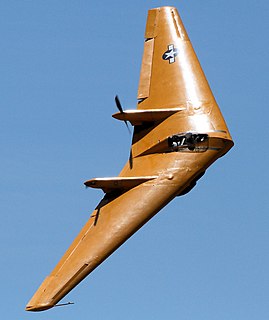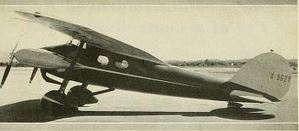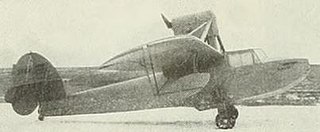Related Research Articles

The Northrop N-9M was an approximately one-third scale, 60-foot (18 m) span all-wing aircraft used for the development of the full size, 172-foot (52 m) wingspan Northrop XB-35 and YB-35 flying wing long-range, heavy bomber. First flown in 1942, the N-9M was the third in a lineage of all-wing Northrop aircraft designs that began in 1929 when Jack Northrop succeeded in early experiments with his single pusher propeller, twin-tailed, twin-boom, all stressed metal skin Northrop X-216H monoplane, and a decade later, the dual-propeller N-1M of 1939–1941. Northrop's pioneering all-wing aircraft would lead Northrop Grumman many years later to eventually develop the advanced B-2 Spirit stealth bomber, which debuted in 1989 in US Air Force inventory.

The IAI Westwind is a business jet initially produced by Aero Commander as the 1121 Jet Commander. Powered by twin GE CJ610 turbojets, it first flew on January 27, 1963, and received its type certification on November 4, 1964, before the first delivery. The program was bought by Israel Aircraft Industries (IAI) in 1968, which stretched it slightly into the 1123 Westwind, and then re-engined it with Garrett TFE731 turbofans into the 1124 Westwind. The 16,800–23,500 lb (7.6–10.7 t) MTOW aircraft can carry up to 8 or 10 passengers, and 442 were produced until 1987.

The Supermarine Scapa was a British general reconnaissance flying boat built by Supermarine that was used by the Royal Air Force between 1935 and 1939. It was developed from the Southampton and formed the basis of the later Stranraer flying boat.

The Great Lakes Sport Trainer is an American biplane trainer and aerobatic aircraft. It was originally produced in large numbers before the company building it went bankrupt in the Great Depression in 1933. Owing to its continuing popularity, however, it was eventually placed back into production in the 1970s and again in 2011 by WACO Classic Aircraft.

The Stearman-Hammond Y-1 was a 1930s American utility monoplane built by the Stearman-Hammond Aircraft Corporation and evaluated by the United States Navy and the British Royal Air Force.

The Thomas-Morse MB-4 was a prototype American mailplane of the 1920s. It was of unusual design, being a biplane with twin fuselages housing the crew of two and a central nacelle which carried the aircraft's twin engines in a push-pull configuration.
The Spartan C5 was a passenger and utility aircraft produced in small numbers in the United States in the early 1930s. It was a further, ultimately unsuccessful, attempt to market the Spartan C4, from which it was developed. Like its predecessor, the C5 was a high-wing, strut-braced monoplane with a fully enclosed cabin. Seating was increased to five places in place of the four seats of the C4. The C5 also incorporated a number of aerodynamic refinements, including a closely cowled engine and spatted mainwheels. The fuselage was constructed of welded steel tube and the wings from wood, and the whole aircraft covered in fabric. The empennage was also mostly constructed from wood, with metal ribs used in the fin and the whole assembly also covered in fabric.

The Burnelli CB-16, also known as the Uppercu-Burnelli CB-300, was a passenger aircraft designed by the American company Burnelli in 1928. It was the first twin-engined aircraft to have retractable landing gear. Only one was built.

The Folkerts SK-2, also known as Speed King Two, "Toots" and "Miss Detroit" was a racer built for the 1936 National Air Races

The Loening SL was an American submarine-based reconnaissance flying boat designed and built by Loening Aeronautical Engineering for the United States Navy.

The Fairchild 228 was a regional jet developed for the United States market by Fairchild Hiller using Fokker F28 sub-assemblies.
The AeroLites Bearcat is an American amateur-built aircraft, designed and produced by AeroLites, of Welsh, Louisiana and introduced in 1984. The aircraft is supplied as a kit for amateur construction.
The AeroLites AeroMaster AG is an American homebuilt agricultural aircraft, designed and produced by AeroLites of Welsh, Louisiana. The aircraft is supplied as a kit for amateur construction.

The Johnson Twin-60 was a small, two seat biplane intended for private owners. It had twin engines for safety and the performance and undercarriage designed for short and rough field use. Despite its refinements only one was definitely built

The Vega Model 2 Starliner was a prototype five-seat feeder airliner produced by the Vega Airplane Company, a subsidiary of Lockheed. It was designed to be powered by an unusual powerplant, consisting of two Menasco piston engines coupled together to drive a single propeller. A single example was built, flying in 1939, but no production followed.

The Miami Maid was a US three passenger amphibian first flown in 1929. Despite ambitious production plans, only two were built.

The Ogden Osprey was a three engine, high wing monoplane airliner which seated six. Designed in the United States and first flown in the spring of 1930 or earlier, six were built and some used commercially before Ogden Aeronautical ceased trading in the Great Depression.

The Cairns A was a low wing, two tandem seat monoplane with a metal structure and stressed metal skin. It first flew late in 1931 with a 90 hp (67 kW) engine but was later fitted with more powerful engines including a 185 hp (138 kW) radial.

The Alcor Duo-4 was a high wing cabin aircraft, unusually powered by a pair of four cylinder straight engines mounted horizontally either side of the nose. After an accident it was rebuilt with six cylinder engines, becoming the Alcor Duo-6. The name Alcor derived from Allan Lockheed Corporation.

The Argonaut Pirate was a 1930s, U.S., three place, single-engined pusher configuration amphibious aircraft. Only two were built.
References
- ↑ "The CRUSADER NX14429 Page of the Davis-Monthan Airfield Register Website". Archived from the original on 2013-10-21. Retrieved 2013-10-10.
- ↑ AAHS Journal: 42. Spring 2004.
{{cite journal}}: CS1 maint: untitled periodical (link) - ↑ E Stanton Brown (August 1935). "The American Gyro Crusader". Popular Science.
- ↑ The Journal of Air Law, Volume 8. p. 71.
- ↑ "Pre-War Tootsietoys - article by Clint Seeley".
- ↑ Aerospace yearbook, Volume 18. Manufacturers Aircraft Association, Manufacturers Aircraft Association, Inc., New York, Aerospace Industries Association of America. p. 268.
- 1 2 3 4 5 Aero Digest April 1935, p. 52.